
The Dead Sea, also known by other names, is a salt lake bordered by Jordan to the east and the West Bank and Israel to the west. It lies in the Jordan Rift Valley, and its main tributary is the Jordan River.

Karst is a topography formed from the dissolution of soluble rocks such as limestone, dolomite, and gypsum. It is characterized by underground drainage systems with sinkholes and caves. It has also been documented for more weathering-resistant rocks, such as quartzite, given the right conditions. Subterranean drainage may limit surface water, with few to no rivers or lakes. However, in regions where the dissolved bedrock is covered or confined by one or more superimposed non-soluble rock strata, distinctive karst features may occur only at subsurface levels and can be totally missing above ground.
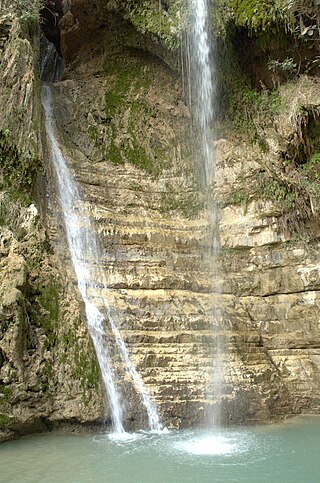
Ein Gedi, also spelled En Gedi, meaning "spring of the kid", is an oasis, an archeological site and a nature reserve in Israel, located west of the Dead Sea, near Masada and the Qumran Caves. Ein Gedi, a kibbutz, was established nearby in 1954.
Emanuel Tov, is a Dutch Israeli, emeritus J. L. Magnes Professor of Bible Studies in the Department of Bible at the Hebrew University of Jerusalem. He has been intimately involved with the Dead Sea Scrolls for many decades, and from 1991, he was appointed Editor-in-Chief of the Dead Sea Scrolls Publication Project.

The Judaean Desert or Judean Desert is a desert in the West Bank and Israel that lies east of Jerusalem and descends to the Dead Sea. Under the name El-Bariyah, it has been nominated to the Tentative List of World Heritage Sites in the State of Palestine, particularly for its monastic ruins.

The Ayyalon Cave is a large limestone cave near Ramla, Israel in which new species of crustaceans were discovered in April 2006. It has been studied for its complex food web, which survived for millions of years without light or organic food coming in from the surface, being based solely on a type of bacterium which feeds on sulfur which serves as the only organic matter available for the next higher level of organisms to feed on. The cave has offered an ecological refuge for species whose relatives living at the surface have been wiped out by climatic changes and catastrophic events over millions of years, and offers a unique sample for the study of long-term ecological changes in the area.
The suprainiac fossa is an elliptical depression on the occiput above the superior nuchal line, or inion, or a dent in the back of the head. Suprainiac fossae were common anatomical features of Neanderthals but are rare in modern Humans.
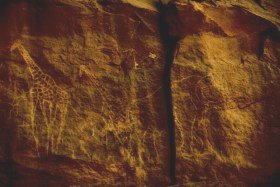
The Sahara pump theory is a hypothesis that explains how flora and fauna migrated between Eurasia and Africa via a land bridge in the Levant region. It posits that extended periods of abundant rainfall lasting many thousands of years in Africa are associated with a "wet-green Sahara" phase, during which larger lakes and more rivers existed. This caused changes in the flora and fauna found in the area. Migration along the river corridor was halted when, during a desert phase 1.8–0.8 million years ago (mya), the Nile ceased to flow completely and possibly flowed only temporarily in other periods due to the geologic uplift of the Nile River region.

Aboud is a Palestinian village in the Ramallah and al-Bireh Governorate of the State of Palestine, in the central West Bank, northwest of Ramallah and 30 kilometers north of Jerusalem. Nearby towns include al-Lubban to the northeast and Bani Zeid to the northwest.
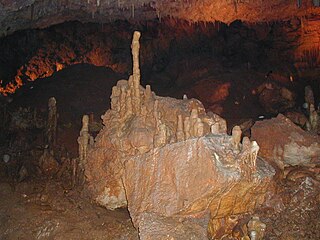
A speleoseismite is a damaged speleothem argued to have been deformed by a seismic event. Speleoseismites can include severed stalagmites, fallen stalactites, collapsed cave ceilings, tilted speleothems, change in growth axis of speleothems, stalactite-stalagmite pair displaced from one another and others. These seismites can be used in paleoseismological studies of ancient earthquakes.
Paul Goldberg is a geologist specializing in geomorphology and geoarchaeology who had done extensive worldwide field researches.

Qesem cave is a Lower Paleolithic archaeological site near the city of Kafr Qasim in Israel. Early humans were occupying the site by 400,000 until c. 200,000 years ago.
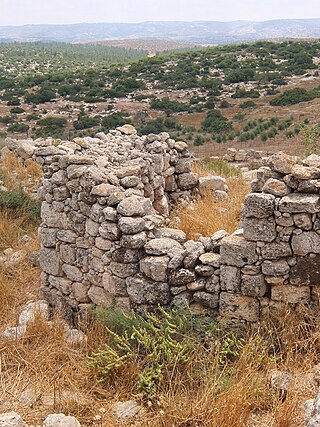
Khirbat Umm Burj was a Palestinian Arab village in the Hebron Subdistrict, sometimes designated in modern maps as Burgin. Its ruins are today located within the borders of Israel. It occupied an extensive site, stretching about 30 dunams on the crest of a hill, rising some 430 metres (1,410 ft) above sea level, and commanding a good prospect of the surrounding region. It was depopulated during the 1948 Arab–Israeli War on October 28, 1948, during the third stage of Operation Yo'av under the command of Yigal Allon. The site is located 17 km northwest of Hebron.
Avi Gopher is an Israeli archaeologist. He is a professor at the University of Tel Aviv.

Hanan Eshel was an Israeli archaeologist and historian, well known in the field of Dead Sea Scrolls studies, although he did research in the Hasmonean and Bar Kokhba periods as well. With Magen Broshi he discovered a number of residential caves in the near vicinity of Qumran and co-published a number of historically significant documents from Qumran.
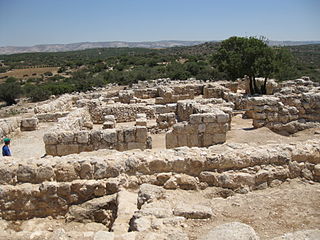
Horvat 'Ethri, Hebrew for "Ethri ruin", Arabic name: Umm Suweid, is an archaeological site situated in the Judean Lowlands in modern-day Israel. Excavations at the site uncovered the remains of a now partially restored Jewish village of the Second Temple period, wherein are preserved an ancient synagogue, wine presses, cisterns, ritual baths and stone ossuaries, as well as an underground hideout system. The village was violently destroyed during the Bar Kokhba revolt.

Manot Cave is a cave in Western Galilee, Israel, discovered in 2008. It is notable for the discovery of a skull that belongs to a modern human, called Manot 1, which is estimated to be 54,700 years old. The partial skull was discovered at the beginning of the cave's exploration in 2008. Its significance was realised after detailed scientific analysis, and was first published in an online edition of Nature on 28 January 2015. This age implies that the specimen is the oldest known human outside Africa, and is evidence that modern humans lived side-by-side with Neanderthals. The cave is also noted for its "impressive archaeological record of flint and bone artefacts". Geologically, it is an "active stalactite cave".
Manot 1 is a fossil specimen designated to a skullcap that represents an archaic modern human discovered in Manot Cave, Western Galilee, Israel. It was discovered in 2008 and the scientific description was published in 2015. Radiometric dating indicates that it is about 54,700 years old, and thought to be directly ancestral to the Upper Paleolithic populations of the Levant and Europe.

Southwest Asian Neanderthals were Neanderthals who lived in Turkey, Lebanon, Syria, Palestine, Israel, Iraq, and Iran - the southernmost expanse of the known Neanderthal range. Although their arrival in Asia is not well-dated, early Neanderthals occupied the region apparently until about 100,000 years ago. At this time, Homo sapiens immigrants seem to have replaced them in one of the first anatomically-modern expansions out of Africa. In their turn, starting around 80,000 years ago, Neanderthals seem to have returned and replaced Homo sapiens in Southwest Asia. They inhabited the region until about 55,000 years ago.
Gerasa (Judaea) was an ancient Jewish town mentioned by the historian Josephus (The Jewish War, 4.9.1) as being sacked by the Imperial Roman army under Lucius Annius during the First Jewish-Roman War.














